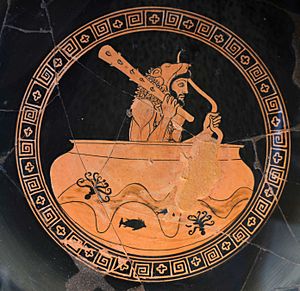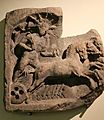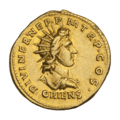Helios facts for kids
Quick facts for kids Helios |
|
|---|---|
| Personification of the Sun | |

|
|
| Major cult center | Rhodes, Corinthia |
| Abode | Sky |
| Planet | Sun |
| Animals | Horse, rooster, wolf, cattle |
| Symbol | Sun, chariot, horses, aureole, whip, heliotropium, globe, cornucopia, ripened fruit |
| Tree | Frankincense, poplar |
| Day | Sunday (hēméra Hēlíou) |
| Mount | A chariot driven by four white horses |
| Gender | Male |
| Festivals | Haleia |
| Personal information | |
| Consort | Many including: Clymene, Clytie, Perse, Rhodos, and Leucothea |
| Children | Achelous, Acheron, Actis, Aeëtes, Aex, Aegiale, Aegle, Aetheria, Aethon, Aloeus, Astris, Augeas, Bisaltes, Candalus, Cercaphus, the Charites, Chrysus, Cheimon, Circe, Clymenus, the Corybantes, Cos, Dioxippe, Dirce, Eiar, Electryone, Helia, Hemera, Ichnaea, Lampetia, Lelex, Macareus, Mausolus, Merope, Ochimus, Pasiphaë, Perses, Phaethon, Phaethusa, Phasis, Phoebe, Phorbas, Phthinoporon, Sterope, Tenages, Theros, Thersanon and Triopas |
| Parents | Hyperion and Theia |
| Siblings | Selene and Eos |
| Equivalents | |
| Roman equivalent | Sol, Sol Invictus |
| Norse equivalent | Sól |
| Etruscan equivalent | Usil |
| Hinduism equivalent | Surya |
| Canaanite equivalent | Shapash |
| Mesopotamian equivalent | Utu |
| Egyptian equivalent | Ra |

Helios (Ancient Greek: Ἥλιος, Hēlios) is the god of the Sun in Greek mythology. He is the son of the Titans Hyperion and Theia. Helios has two sisters: Selene, who is the goddess of the Moon, and Eos, the goddess of the dawn. In Roman mythology, Helios was known as Sol.
Helios is often shown in art with a radiant crown. He drives a chariot pulled by horses across the sky each day.
Contents
Mythology
Helios, God of the Sun
In the Iliad, Hera once made Helios set earlier than usual. This happened during a battle to help the Greeks. Later, after her son Memnon was killed, Hera made Helios's light dim. This allowed her to secretly take her son's body away.
When Heracles was on his way to get the cattle of Geryon, he crossed a hot desert. He became so annoyed by the heat that he shot an arrow at Helios. Heracles quickly realized his mistake and said sorry. Helios, impressed by Heracles's bravery, gave him a special golden cup. Helios used this cup to sail across the sea every night, from west to east. Heracles used the cup to reach Erytheia and returned it after his task was done.
The Island of Rhodes

When the gods divided the earth among themselves, Helios was not there. So, he did not get any land. He complained to Zeus, who offered to do the division again. But Helios refused. He had seen a new island rising from the sea. It was a rich and fertile land.
Helios asked for this island to be his, and Zeus agreed. Another story says Helios himself made the island rise. He named it Rhodes, after his lover Rhode. She was the daughter of Poseidon and Aphrodite or Amphitrite. Rhodes became Helios's special island, where he was honored more than other gods.
Phaethon's Wild Ride
One of Helios's most famous stories is about his mortal son, Phaethon. Phaethon asked his father for a favor. Helios agreed, but then Phaethon asked to drive Helios's fiery, four-horse chariot across the sky for one day. Helios warned his son many times about the dangers. He explained how difficult and risky the journey was.
However, Phaethon insisted, so Helios gave him the reins. As expected, the ride was a disaster. Phaethon could not control the powerful horses. The chariot went too high, freezing parts of the Earth, and too low, scorching others. To stop him from destroying the world, Zeus struck Phaethon with a lightning bolt.
The Watchman
Helios saw and witnessed everything that happened under his light. He was often called upon to swear oaths because he saw all.
Persephone's Abduction
When Hades took Persephone to the Underworld, Helios was the only one who saw it. Persephone's mother, Demeter, searched everywhere for her daughter. She came to Helios and asked if he had seen anything. Helios felt sad for Demeter. He told her that Hades had taken Persephone to be his wife and queen, with Zeus's permission.
Leucothoe and Clytie

The goddess Aphrodite made Helios fall in love with a mortal princess named Leucothoe. Because of this, Helios forgot about his previous lover, the nymph Clytie. Helios would watch Leucothoe from above. He even made winter days longer so he could spend more time looking at her.
Helios disguised himself as Leucothoe's mother, Eurynome. He entered their palace and went into Leucothoe's room. He sent her servants away, pretending he wanted to tell his "daughter" a secret. Then, he showed his true form to the girl.
However, Clytie, who was still in love with Helios, told Leucothoe's father, Orchamus, about the affair. Orchamus was furious and punished Leucothoe severely. Helios arrived too late to save her. He was very sad, just like when Phaethon died. He could not bring Leucothoe back to life. Instead, he poured nectar onto the earth, turning her into a frankincense tree. This way, she could still breathe instead of decaying underground.
Clytie had hoped this would make Helios return to her. But he was angry with her for causing Leucothoe's death. He wanted nothing to do with Clytie and left. Clytie then sat on a rock for nine days without food or drink, longing for him. Helios never looked back at her. Eventually, she turned into a purple, sun-gazing flower called the heliotrope. This flower follows Helios's movement in the sky, still showing her love for him.
The heliotrope flower was described as purple or like a violet. However, later stories and art often showed it as a yellow sunflower. Sunflowers are from North America, not Greece or Italy. So, ancient writers would not have known about them.
Helios's Family
Helios had a large family. The Oceanid nymph Perse was traditionally seen as his wife. They had several children together. In the Rhodian tradition, Helios married Rhodos and had seven sons with her.
| Consort | Children | Consort | Children | Consort | Children | ||
|---|---|---|---|---|---|---|---|
| Athena | • The Corybantes | Rhodos (a nymph) |
• The Heliadae | Ephyra (an Oceanid) |
• Aeëtes | ||
| Aegle, (a Naiad) |
• The Charites | 1. Tenages | Antiope | • Aeëtes | |||
| 1. Aglaea "splendor" |
2. Macareus | • Aloeus | |||||
| 2. Euphrosyne "mirth" |
3. Actis | Crete | • Pasiphaë | ||||
| 3. Thalia "flourishing" |
4. Triopas | Gaia | • Bisaltes | ||||
| Clymene (an Oceanid) |
• The Heliades | 5. Candalus | • Achelous | ||||
| 1. Aetheria | 6. Ochimus | Hyrmine or | • Augeas | ||||
| 2. Helia | 7. Cercaphus | Iphiboe or | |||||
| 3. Merope | 8. Auges | Nausidame | |||||
| 4. Phoebe | 9. Thrinax | Demeter or | • Acheron | ||||
| 5. Dioxippe | • Electryone | Gaia | |||||
| • Phaethon | Perse (an Oceanid) |
• Calypso | unknown woman | • Aethon | |||
| • Astris | • Aeëtes | unknown woman | • Aix | ||||
| • Lampetia | • Perses | unknown woman | • Aloeus | ||||
| Rhode (a Naiad) |
• Phaethon | • Circe | unknown woman | • Camirus | |||
| Prote (a Nereid) |
• Pasiphaë | • Aloeus | unknown woman | • Ichnaea | |||
| • The Heliades | Neaera (perhaps an Oceanid) |
• Phaethusa | unknown woman | • Mausolus | |||
| Ocyrrhoe (an Oceanid) |
• Lampetia | Asterope | • Aeëtes | unknown woman | • Phorbas | ||
| Leda | • Phasis | • Circe | unknown woman | • Sterope | |||
| Clytie (an Oceanid) |
• Helen | Ceto (an Oceanid) |
• Astris | unknown woman | • Eos | ||
| Selene | • No known offspring | Leucothoe or | • Thersanon | unknown woman | • Selene | ||
| unknown woman | • The Horae (possibly) |
Leucothea | unknown woman | • Hemera | |||
| • Aeëtes | unknown woman | • Cronus (Orphic) |
unknown woman | • Dirce | |||
| • Perses | unknown woman | • Clymenus | unknown woman | • Lelex | |||
| unknown woman | • Cos | unknown woman | • Chrysus | unknown woman | • Aegiale |
Namesakes
- The crane fly Helius is a type of insect named after the god.
- Two space probes launched by NASA to study the sun were named Helios A and Helios B.
- One of the craters on Hyperion, a moon of Saturn, is named after Helios.
- The chemical element Helium was named after Helios by scientists Norman Lockyer and Edward Frankland.
Interesting Facts About Helios
- Helios is a god who sees and hears everything. He can observe both gods and mortals. Because of this, people often called on him when making important promises or oaths.
- He also played a big part in ancient magic and spells.
- The Roman Emperor Julian made Helios the main god in the 4th century AD.
- People believed that summer days are longer because Helios sometimes stops his chariot in the sky. He would pause to watch nymphs dancing during the summer.
- The Colossus of Rhodes was a giant statue of Helios. It stood in the port of Rhodes until an earthquake destroyed it.
Images for kids
-
Helios relief (1830), Stuttgart, Rosenstein Castle.
-
Helios in front of Mithras, fresco from a Mithraeum, Hama museum, Syria.
-
Hera makes Helios set earlier, Iliad engraving, John Flaxman.
-
Helios rising in his chariot, red-figure calyx-krater, 430 BC (circa), British Museum.
-
Phaethon meets the Sun, engraving for the Metamorphoses.
-
Helios and Phaethon with Saturn and the Four Seasons, by Nicolas Poussin, oil on canvas.
-
Blind Orion Searching for the Rising Sun, by Nicolas Poussin, 1658, oil on canvas.
-
Helios and chariot depicted on the dome of the entrance hall of the Széchenyi Bath, Budapest.
-
Bust of Helios in a clipeus, detail from a strigillated lenos sarcophagus, white marble, early 3rd century CE, Tomb D in Via Belluzzo, Rome.
-
Silver drachma coin from Rhodes island with the head of Helios looking to the right and bearing a diadem of rays, ca. 170-150 BC, University of Tübingen, Berlin.
-
Quadriga of the Sun, sixth century BC, Temple C, Selinunte.
-
The Temple of Garni, late first century, Armenia, dedicated to the solar god Helios-Mihr, from a syncretic Helleno-Armenian cult.
-
Magical sphere with Helios and magical symbols from the theatre of Dionysus, Acropolis Museum, Athens.
-
Coin of Roman Emperor Constantine I depicting Sol Invictus/Apollo with the legend SOLI INVICTO COMITI, c. 315 AD.
-
Bust of Alexander the Great as an eidolon of Helios (Musei Capitolini).
-
Helios as the personification of midday, renaissance painting by Anton Raphael Mengs (c. 1765) showing apollonian traits, such as the lack of a chariot, that were absent in mythology and Hellenic art.
-
Helios in the Sun chariot accompanied by Phosphorus and Hermes, fresco at Nymphenburg Palace, Munich.
-
Serapis with Moon and Sun, oil lamp, Roman terracotta, British Museum.
-
Helios witnessing the birth of Athena, detail from the pediment (far-left) of the Academy of Athens, by Leonidas Drosis, Greece.
-
Sol in the east side of the Arch of Constantine, Rome.
-
Helios in the Hammat Tiberias mosaic, Israel.
-
Apollo fountain in the Palace of Versailles, France.
-
Apollo in the Forge of Vulcan, by Diego de Velázquez, oil on canvas.
-
Helios in one of the many stamps issued in 1947-53, celebrating the unification of the Dodecanese with Greece.
-
Odysseus' men eat the oxen, as a woman informs Helios, mounted on his chariot, engraving by Theodoor van Thulden, 1632–1633, Rijksmuseum, Netherlands.
See also
 In Spanish: Helios para niños
In Spanish: Helios para niños














































